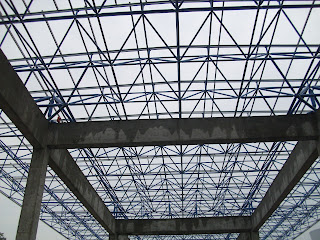Steel Space Structures in Exhibition and Convention Centers — Balancing Aesthetics and Functionality
Exhibition and convention centers are some of the most complex architectural spaces in modern construction. They demand vast, column-free interiors, striking architectural forms, and flexible layouts to host different kinds of public events. In these large-scale venues, steel space structures have become the preferred solution for achieving both aesthetic appeal and structural efficiency.
1. Meeting the Challenges of Large Exhibition Halls
Convention and exhibition centers must serve multiple functions — from international expos to cultural gatherings. Architects and engineers face several major challenges:
-
They need large, open spaces free from columns that would block movement or visibility.
-
The roof must span up to 100–150 meters while remaining lightweight and stable.
-
The structure should be visually impressive, reflecting the prestige of the city or region.
-
It must also allow easy maintenance and future modification for different event setups.
Steel space structures make all these possible through their efficient three-dimensional load-bearing design.
2. Why Steel Space Structures Are Ideal for Exhibition Buildings
Lightweight strength is the defining advantage of space structures. Their interconnected triangular elements distribute weight evenly, allowing wide spans with less material.
-
They reduce steel consumption while increasing overall stability.
-
The system allows for complex shapes, from flat grids to curved or domed forms, without compromising strength.
-
Prefabricated components shorten construction time, which is especially valuable in urban sites.
-
They integrate well with modern facade materials like glass, ETFE membranes, or aluminum panels.
This combination of practicality and visual lightness has made space structures a hallmark of modern exhibition architecture.
3. Design and Engineering Innovations
Recent advancements have pushed steel space structure performance even further:
-
BIM and digital fabrication ensure millimeter-level accuracy during production and installation.
-
High-strength, corrosion-resistant steel extends lifespan, even in humid coastal regions.
-
Composite nodes and modular connections simplify transport and on-site assembly.
-
In earthquake-prone regions, the multi-directional stiffness of space structures enhances safety under seismic loads.
These innovations make space structures not only efficient but also resilient and sustainable.
4. Real-World Applications
Across Asia, the Middle East, and Europe, many landmark convention centers use steel space frames for their roof systems.
For example, the Shenzhen World Exhibition & Convention Center in China — one of the largest in the world — uses a double-layer space structure roof system to cover halls spanning over 100 meters each. The design achieves both architectural impact and high energy efficiency through integrated skylights and photovoltaic panels.
5. Future Trends in Exhibition Architecture
The future of exhibition and convention halls will move toward sustainability, adaptability, and intelligent monitoring.
Steel space structures will remain key to this transformation by:
-
Supporting modular layouts that allow reconfiguration for different functions.
-
Enabling light-filled, energy-saving roofs with smart glazing systems.
-
Integrating real-time structural monitoring sensors to ensure long-term safety and performance.
Conclusion
Steel space structures have transformed the possibilities for modern exhibition buildings. They combine elegance with engineering precision, offering flexibility for diverse uses while reducing material costs and environmental impact.
👉 Looking to design or supply space structures for large public venues? Contact us today to explore customized solutions for your next iconic project.




评论
发表评论